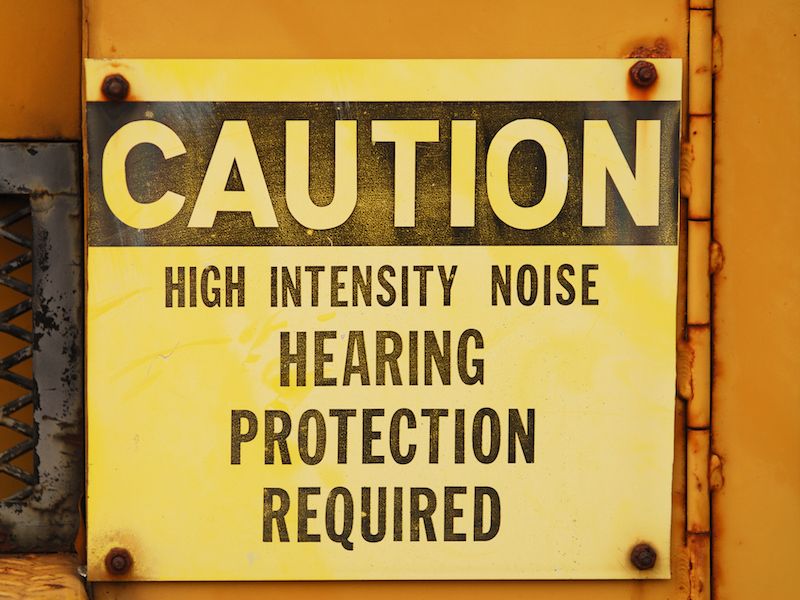
Realizing you should safeguard your hearing is one thing. It’s another matter to know when to protect your ears. It’s not as easy as, for example, knowing when to wear sunscreen. (Is it sunny and are you going to be outside? Then you need sunscreen.) It’s not even as simple as determining when to wear eye protection (Working with dangerous chemicals? Doing some construction? You need to wear eye protection).
It can feel as though there’s a significant grey area when dealing with when to wear hearing protection, and that can be detrimental. Frequently, we’ll defer to our normal inclination to avoid hearing protection unless we’re given information that a specified activity or place is hazardous.
Determining The Risks
In general, we’re not very good at assessing risk, especially when it comes to something as intangible as damage to the ears or the possibility of permanent sensorineural hearing loss. Here are some examples to demonstrate the situation:
- Person A attends a very loud rock concert. 3 hours is approximately the length of the concert.
- Person B runs a landscaping company. She spends a significant amount of time mowing lawns, then she goes home to a quiet house and reads.
- Person C works in an office.
You may think that person A (let’s call her Ann, to be a little less clinical) may be in more hearing danger. For most of the next day, her ears will still be ringing from the loud concert. Presuming Ann’s activity was risky to her ears would be fair.
Person B (let’s just call her Betty), on the other hand, is exposed to less noise. There’s no ringing in her ears. So it has to be safer for her hearing, right? Well, not quite. Because Betty is pushing that mower all day. So even though her ears don’t ring out with pain, the damage builds up bit by bit. If experienced every day, even moderately loud noise can have a damaging affect on your ears.
Person C (let’s call her Chris) is even less clear. Most people recognize that you need to safeguard your hearing while using equipment such as a lawnmower. But even though Chris works in a quiet office, she has a very noisy, hour-long commute each day through the city. What’s more, she sits at her desk and listens to music through earbuds. Does she need to think about protection?
When is it Time to Begin Thinking About Safeguarding Your Hearing?
The normal guideline is that if you have to raise your voice in order to be heard, your environment is noisy enough to do harm to your ears. And you should think about using earplugs or earmuffs if your surroundings are that loud.
So to put this a bit more clinically, you need to use 85dB as your cutoff. Sounds above 85dB have the ability to result in injury over time, so in those circumstances, you need to think about wearing hearing protection.
Most hearing specialists advise using a special app to keep track of noise levels so you will be aware when the 85dB has been reached. These apps can tell you when the ambient noise is getting close to a harmful level, and you can take proper steps.
A Few Examples
Your phone might not be with you anywhere you go even if you do download the app. So we might establish a good standard with a couple of examples of when to safeguard our hearing. Here we go:
- Residential Chores: We already mentioned how something as basic as mowing the lawn, when done often enough, can necessitate hearing protection. Chores, like mowing, are probably something you don’t even think about, but they can result in hearing impairment.
- Listening to music with earbuds. OK, this doesn’t call for protection but does require care. Whether your music is playing directly into your ears, how loud it’s playing, and how long you’re listening to it are all things you need to pay attention to. Noise-canceling headphones are a great choice to avoid having to turn the volume way up.
- Using Power Tools: You know that working every day at your factory job will call for hearing protection. But how about the enthusiast building in his garage? Even if it’s just a hobby, hearing specialists recommend wearing hearing protection if you’re using power equipment.
- Driving & Commuting: Do you drive for Lyft or Uber? Or maybe you’re taking a subway after waiting for a while downtown. The constant noise of living in the city, when experienced for between 6 and 8 hours a day, can cause damage to your hearing over the long term, particularly if you’re turning up your music to hear it over the commotion.
- Exercise: Your morning cycling class is a great example. Or maybe your nighttime yoga session? All of these cases could require ear protection. Those trainers who use microphones and sound systems (and loud music) to motivate you might be good for your heart rate, but all that volume is bad for your hearing.
A strong baseline may be established by these examples. If there is any doubt, though, use protection. Instead of leaving your ears exposed to future injury, in most cases, it’s better to protect your ears. Protect today, hear tomorrow.

